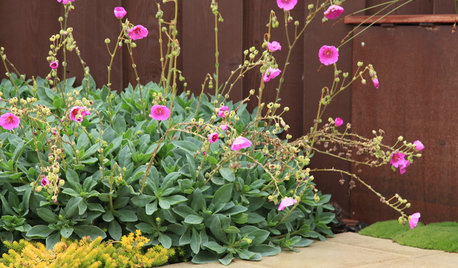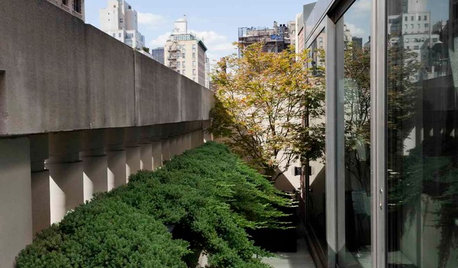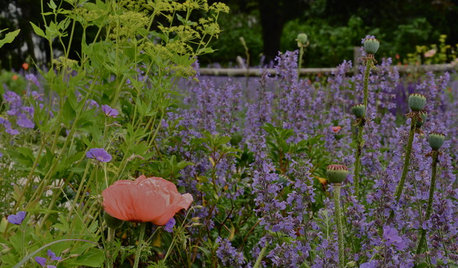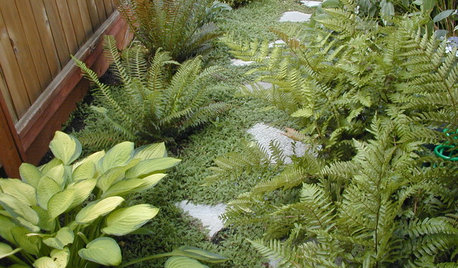For my front yard, I need to establish a no-mow ground cover that grows no higher than 12". That is the guideline given to me by my town's weed enforcement officer. Yes, we have one! As long as it is a monoculture and not listed as a weed I can grow pretty much anything I want to a height of 12" in my front and side yards. Unofficially. Officially the weed police = God.
Currently there is no lawn. Just some weeds that have an uncanny resemblance to skunk cabbage, a bit of some kind of grass, a few remnants of some white clover I planted many years ago, and mostly mud. As soon as it stops raining here I plan to nuke everything with some newly generic glyphosate.
Every year I scrape the topsoil from my front yard to tame the weeds. What's left isn't very fertile. Even mint has trouble growing. I planted some chocolate mint last year and it hasn't grown at all. I have a clump of spearmint that grows but doesn't spread. The fact that a skunk cabbage-ish plant is my dominant weed and the fact that even a brief rain shower forms puddles which take more than 24 hours to be absorbed leads me to conclude that I have poor drainage. This seems to rule out all but a small fraction of ground cover options, leaving mostly semi-aquatics and an elite group of seriously tough customers who don't care what they grow in.
With poor drainage the topic of soil amendments or raised beds is sometimes brought up. I think either would be rather expensive. The soil is sufficiently hard that I can jump up and down on a sharp shovel and penetrate no more than a a few inches even when the ground is wet and that's if I'm lucky about where I put the shovel. I think amending it would be...challenging. The raised bed thing might be possible in the sense that I could maybe buy a truckload of loam and spread it around on top of the hard pack. I also still have the piles of topsoil that have accumulated. Unless I can manage to add a lot of soil I don't think it will be game changing and at the moment I'm not prepared to spend the money.
So assuming the conditions of hard, rocky, clay with poor drainage what are my options for a In terms of versatility, aggressiveness, attractiveness, and height Creeping Jenny seems hard to beat. One problem is the lack of seed. That makes it expensive to establish in any reasonable amount of time. I just ordered around 30 plugs of the 'aureus/goldilocks' chartreuse cultivar. As soon as the plugs grow out I'm hoping to help them to spread even further by clipping and rooting some cuttings. Nevertheless I am not expecting them to spread fast enough to stop the weeds this season. Or even the next. And, since I know next to nothing about gardening or botany, that's where things get complicated.
I'm having trouble coming up with a strategy. My goal is to establish a weed-choking, attractive ground cover ASAP. Creeping Jenny would be my first choice, but I'm not sure I am willing to wait 2-3 more seasons for the Lysimachia to form a dense, weed-choking carpet. I'm trying to figure out if there is some way to plant something that will fill in the gaps left after the Lysimachia plantings.
Presumably I should be thinking in terms of an annual or just something less hardy than zone 6. Maybe 8+ to be safe. And something that doesn't spread or spreads very little and can grow from quickly germinating seed. I guess my first question would be whether this idea of a temporary filler plant to help battle the weeds makes any sense. I don't know exactly how fast the Lysimachia will creep. I certainly wouldn't want to obstruct its path with a competing plant. Unless the filler plant is a very fast grower, it might not even out-compete the weeds anyway. It may even make weeding more difficult by mixing with the weeds so that I cannot spray glyphosate without also hitting the filler plant foliage.
On the other hand I really want to get some ground cover down there. Despite my desire for a Creeping Jenny monoculture in the front yard, it is difficult to resist throwing something in the gaps. But the filler plant idea is starting to seem like more and more of a bad one. Perhaps it would be better to put some of the money I'd save by not buying any more plants toward a pre-emergent herbicide. Since I'm not propogating the Lysimachia by seed, presumably a pre-emergent wouldn't hurt. It would just have to no longer be active in the fall when I sow the Rush seeds for the spring.
That's another complication. Where to place the Rush seeds. Maybe I should divide the yard in half and plant the Lysimachia on the drier top of the hill and plan for a Rush emergence at the wetter bottom half of the hill next spring. That strategy would seem to invite a temporary non-hardy annual ground cover at the bottom of the hill where it wouldn't be in the way. Any suggestions for that? The idea of Corsican Mint has occurred to me. Seems like a nearly ideal ground cover aside from its delicate and fussy nature. The seeds are kind of pricey, but it's something I'd love to work with. Like most mints, "well-drained" soil seems to be a requirement though.
















vetivert8
Related Professionals
Maple Valley Landscape Architects & Landscape Designers · Bellflower Landscape Architects & Landscape Designers · Fort Lee Landscape Architects & Landscape Designers · Zion Landscape Architects & Landscape Designers · Fuquay-Varina Landscape Contractors · Plainview Landscape Contractors · Pomona Landscape Contractors · Richmond Landscape Contractors · San Rafael Landscape Contractors · Yukon Landscape Contractors · Irvington Landscape Contractors · San Pablo Landscape Contractors · Jacksonville Window Contractors · Lake Forest Park Window Contractors · Sudbury Window Contractors